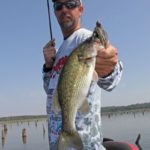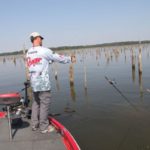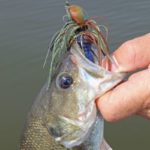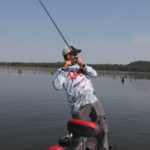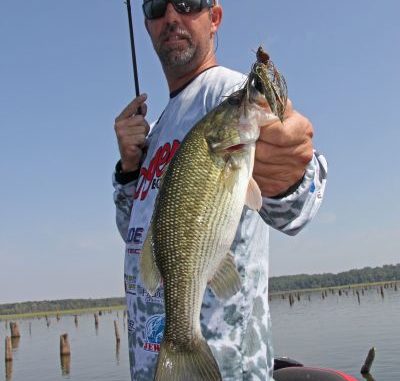
Be creativity and innovative with your flipping rigs to enhance your bass-fishing success.
Traffic, taxes, vending machines that take our money but withhold the candy bar — life’s full of irritations and aggravations that prompt the occasional flip-out.
But while that’s a list we can do without, there’s a list of positive variables that most — at least those bass anglers among us — can appreciate.
How about a handful of tips for improving your flipping game?
For clarity, flipping encompasses jigs or Texas-rigged plastics.
Sometimes, the choice is simply personal preference, but Bassmaster Elite Series pro Jason Christie uses water temperature as a general rule of thumb.
Below 60 degrees and right up through the prespawn, Christie likes a jig because it imitates crawfish — the dominant forage.
From the spawn through summer, he’s more likely to work a Texas rig with baits designed for more of a finfish ruse. He might work in some jig work through the warmer months, but this bait resumes its prominence in his flipping plan once fall starts lowering those water temps again.
Here’s a handful of suggestions for flipping success:
• Bait Bling — Mississippi pro Roger Stegall’s a big fan of the Carolina rig, so much so that he pulls a piece of that presentation into his Texas-rigged flipping baits.
With worms, creature baits or any plastic, he’ll add a plastic bead between the weight and the hook to add a visual accent plus that intriguing clicking sound that always seems to convince bass to look in the right direction.
“That noise is what attracts a fish’s attention to your Carolina rig, so I use the same (strategy) for my Texas rigs,” Stegall said. “That bead also protects your knot when you’re using a heavy tungsten flipping weight.”
A red bead is most common, but don’t hesitate to experiment with other colors. Gold, for example, is a good eye-catcher in stained or muddy water. Pick up a fashion mag if needed, but it’s a fact — accessorizing makes the outfit.
• Middle Matters — According to FLW Tour pro and Forrest Wood Cup champion Randall Tharp, heavy tungsten weights can cut your line when you swing and miss so weights with inserts are his preference.
Tharp modifies those made without inserts by inserting a small section of heat-shrink tubing, which will form to the weight’s interior with a little cigarette lighter action while maintaining its own interior to allow line passage.
He also adds a small section of heat-shrink tube over the existing keeper on a flipping hook and leaves about a 1/16-inch lip on the hook shank at the lower edge. This increases the keeper’s diameter, so it holds baits more securely while creating a smaller entry point when fitting a bait onto the keeper.
• Stand Up and Stick ’Em — Bassmaster Elite pro Greg Hackney always snells his flipping hooks to ensure they stand up on the hook set for maximum hooking efficiency.
Often, he notes, a hard hook set with a big weight will pop the fish’s mouth open, and a hook rigged with an eye knot like a Palomar will usually follow the weight right out of the fish’s mouth.
Snelling pulls the hook into just about a right angle with the line, and that gives the point a much better chance of grabbing some lip.
“It only takes me a few more seconds to snell a hook than it does to tie a more-common knot like a Palomar, and this gives me 100-percent confidence in my hook sets,” Hackney said. “The key is to run your line through the hook eye front to back. This ensures your hook kicks up the right way. If you tie that knot the wrong way, your hook kicks downward and you’ll miss fish.”
• Dig the Jig — Legendary flipper Denny Brauer helped design several Strike King jig models, but he’ll still put each new jig through the ringer to make sure everything is as it should be.
One key test is hook sharpness. Brauer tests his jigs by poking the hook point against his thumbnail and tugging slightly downward. A properly sharpened hook digs in and holds, while a hook that drags and scrapes his thumbnail earns a trip to the sharpener.
Another Brauer jig tip: Trim the tips of the weed guard strands at a 45-degree angle so they’re level with the hook point. This eliminates the occasional vexation of a thick hook guard impeding a hook set.
• Backside Basics — On his jigs, Christie uses trailers that mimic defensive crawfish: Yum Craw Papis and Yum Craw Chunks.
He’ll use the streamlined Papi when he wants to trigger active fish with a faster fall, but if a tough bite (i.e., during weather changes or heavy fishing pressure) requires a more measured descent he leverages the Chunk’s bulkier profile and active flappers to slow the jig’s rate of fall.
For instance, his standard ½-ounce Booyah jig has a quick fall rate when paired with a modest trailer. However, beefing up the profile with a larger trailer moderates that fall.
“With a big, bulky trailer I can make that jig act like a 3/8- or a ¼-ounce (version), but I can still flip it in the wind like (a heavier jig),” Christie said.
• Small Bed Baits — For bed fishing and other close-range flipping scenarios, Texas pro Russell Cecil likes the 3 ½-inch Big Bite Baits Warmouth because it mimics the little panfish that drive bass crazy during the spawn and keep them well fed throughout much of the year.
The only drawback is that the short body makes it tough to use a full-size flipping hook. For this reason, Cecil uses a 5/0 Owner heavy wire hook because it has a wide gap with a short shank. The hook’s deep “bite” (the measurement of a hook’s bend to the gap line) allows him to flip a smaller bait that’s ready to latch onto a big fish.
“I like that hook because the short shank allows me to use a smaller bait, but with that much gap you get all of that bait out of the way,” Cecil said. “You have a lot of deep bite in that hook, and it’s a 2X strong (hook) so it works well with braid.”
• Go Big or Go Home — While shorter, compact baits get a lot of the grass duty, Toledo Bend guide Stephen Johnston won’t hesitate to Texas rig a jumbo worm of 10-plus inches.
“When those fish are seeking shelter in that hydrilla, they’ll wait for a big meal to come by, and that big worm looks like something they’d want to eat,” Johnston said.
• Stick It to ’Em — For wide-gap hooks and anything without a built-in, Bassmaster Elite pro Terry Scroggins holds his bait in place by pulling the eye down into the bait’s head (after Texas-style rigging), poking a toothpick through the bait, into the hook eye and then out the other side. He’ll snug up the entry side and clip the exit side close to the plastic.
Neater and quicker than glue, one toothpick equals two bait fixes.
• Double Duty — Rigging a medium-sized bullet weight with a bobber stopper on his Senko allows Bassmaster Elite pro Kevin Hawk to multi-task with a single bait.
He can swim his slender stick bait through the pads, grass lines, etc., and move easily with the nose weight. If he spots a stump, laydown or hole in the vegetation, he can quickly transition to a flipping presentation.
